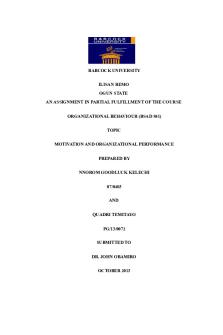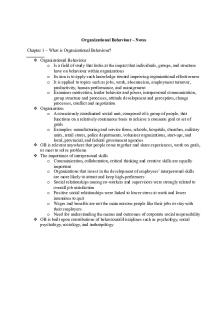Organizational Behaviour Project PDF

| Title | Organizational Behaviour Project |
|---|---|
| Author | Varun Modasia |
| Course | Organizational Behaviour And Human Resource Management |
| Institution | Gujarat National Law University |
| Pages | 15 |
| File Size | 451.5 KB |
| File Type | |
| Total Downloads | 84 |
| Total Views | 244 |
Summary
Case study of organization behavior of vodafone company. ...
Description
ORGANIZATIONAL BEHAVIOUR
Submitted By: Varun Modasia Batch: 2017-2022 Sem: V Roll No:14 Submitted To: Malay Patel Asst. Professor
DECLARATION
The text reported in the project is the outcome of my own efforts and no part of this project assignment has been copied in any unauthorized manner and no part of it has been incorporated without due acknowledgement.
Name: Varun Modasia Sign:
1
TABLE OF CONTENTS
DECLARATION........................................................................................................................1 TABLE OF CONTENTS...........................................................................................................2 INTRODUCTION......................................................................................................................3 ABOUT ORGANIZATIONAL BEHAVIOUR:.................................................................3 ABOUT TELECOM INDUSTRY:.....................................................................................3 ABOUT VODAFONE:.......................................................................................................4 BACKGROUND........................................................................................................................5 ORGANIZATIONAL STRUCTURE OF VODAFONE...........................................................6 TRAITS GOVERNING VODAFONE:..............................................................................6 DIVERSITY AND INCLUSION...............................................................................................7 GENERAL:.........................................................................................................................7 DRIVING DIVERSITY INTERNALLY:...........................................................................7 HUMAN RESOURCE PRACTICES........................................................................................9 LITERATURE REVIEW OF STRATEGIC HRM:..........................................................10 RECRUITMENT & SELECTION:..................................................................................10 LEARNING:.....................................................................................................................11 EMPOWERMENT...........................................................................................................11 RETENTION....................................................................................................................12 ENCOURAGED INDIVIDUAL COMMITMENT.........................................................12 DELEGATION, MENTORING AND COACHING........................................................12 HANDLING UNDER-PERFORMANCE........................................................................13 EMPLOYEE RELATIONS..............................................................................................13 CONCLUSION........................................................................................................................13 BIBLIOGRAPHY....................................................................................................................14
2
INTRODUCTION
ABOUT ORGANIZATIONAL BEHAVIOUR: “Organisational behaviour is the study and application of knowledge about how people act within an organisation. It is a human tool for human benefit. It applies broadly to the behaviour of people in all types of organisation.”— Newstrom and Davis. “Organisational behaviour is a field of study that investigates the impact that individuals, groups and structure have on behaviour within the organisations for the purpose of applying such knowledge toward improving an organization’s effectiveness.”— Stephens P. Robbins. Organizational studies encompass the study of organizations from multiple viewpoints, methods, and levels of analysis. For instance, one textbook divides these multiple viewpoints into three perspectives: modern, symbolic, and postmodern. Another traditional distinction, present especially in American academia, is between the study of “micro” organizational behaviour – which refers to individual and group dynamics in an organizational setting – and “macro” strategic management and organizational theory which studies whole organizations and industries, how they adapt, and the strategies, structures and contingencies that guide them. To this distinction, some scholars have added an interest in “meso” scale structures – power, culture, and the networks of individuals and i.e. ronit units in organizations – and “field” level analysis which study how whole populations of organizations interact. ABOUT TELECOM INDUSTRY: The telecommunication sector is made up of companies that make communication possible on a global scale, whether it is through the phone or the Internet, through airwaves or cables, through wires or wirelessly. These companies created the infrastructure that allows data in words, voice, audio or video to be sent anywhere in the world. The largest companies in the sector are telephone (both wired and wireless) operators, satellite companies, cable companies, and internet service providers. Not long ago, the telecommunications sector consisted of a club of big national and regional operators. Since the early 2000s, the industry has been swept up in rapid deregulation and innovation. In many countries around the world, government monopolies are now privatized and they face a plethora of new competitors. Traditional markets have been turned upside
3
down, as the growth in mobile services outpaces the fixed line and the internet starts to replace voice as the staple business. ABOUT VODAFONE: The name Vodafone comes from voice data fone, chosen by the company to, “reflect the provision of voice and data services over mobile phones”. Vodafone is one of the leading mobile communications company with setup in 27 countries and collaboration agreements with more than 35 countries, including Safaricom in Kenya. The company provided the opportunities for over 71,000 employees across the world and in 2008 had more than 289 million customers. More than 19 million people use Vodafone services in the United Kingdom Vodafone’s aim is ‘to be the world’s number one mobile communications leader’ and a vital component of this is to ensure that customers beliefs and approve of the company. It achieves this by taking a responsible approach to the way it conducts its business. This augment its status and in order to develop customers loyalty. Vodafone’s business strategy and its Corporate Responsibility (CR) strategy are interlinked. The company trust that long-term business rewards come from doing business in a sustainable way. Vodafone India was the Indian subsidiary of UK-based Vodafone Group plc and was a provider of telecommunications services in India with its operational head office in Mumbai. As of March 2018, Vodafone India had a market share of 21% with approximately 223 million subscribers and was the second largest mobile telecommunications network nationally after Airtel.
4
BACKGROUND
Hutchison Max Telecom Ltd. (HMTL), a joint venture between Hutchison Whampoa and the Max Group, was established on 21 February 1992. The licence to operate in Mumbai (then Bombay) circle was awarded to Hutchison Max by the Department of Telecommunications (DoT) in November 1994. The cellular service branded "Max Touch" was launched the same year. Hutchison Max entered into the Delhi telecom circle in December 1999, the Kolkata circle in July 2000 and the Gujarat circle in September 2000. Licences for these circles had initially been awarded by the DoT in 1994, 1997 and 1995 respectively. Between 1992 and 2006, Hutchison acquired interests in all 23 mobile telecom circles of India. HMTL was renamed Hutchison Essar Limited (HEL) in August 2005. In Delhi, Uttar Pradesh (East), Rajasthan and Haryana, Essar Group was the major partner. But later Hutch took the majority stake. By the time of Hutchison Telecom's Initial Public Offering in 2004, Hutchison Whampoa had acquired interests in six mobile telecommunications operators providing service in 13 of India's 23 licence areas and following the completion of the acquisition of BPL Mobile that number increased to 16. In 2006, it announced the acquisition of a company (Essar Spacetel — A subsidiary of Essar Group) that held licence applications for the seven remaining licence areas. Initially, the company grew its business in the largest wireless markets in India — in cities like Mumbai, Delhi and Kolkata. In these densely populated urban areas it was able to establish a robust network, well-known brand and large distribution network – all vital to long-term success in India. In February 2007, Hutchison Telecom announced that it had entered into a binding agreement with a subsidiary of Vodafone Group Plc to sell its 67% direct and indirect equity and loan interests in Hutchison Essar Limited for a total cash consideration (before costs, expenses and interests) of approximately $11.1 billion. The Acquisition was completed on May 8, 2007. The brand subsequently introduced ZooZoos which gained even higher popularity than was created by the Pug. Vodafone's creative agency is O&M while Harit Nagpal was the Marketing Director during the various phases of its brand evolution.
5
ORGANIZATIONAL STRUCTURE OF VODAFONE
TRAITS GOVERNING VODAFONE: There are different kinds of traits found in the organization, we have many traits being followed in Vodafone such as Autocratic, Bureaucratic, Democratic, Charismatic, Transformational and many more. These all have their importance in their desired positions and timings. But among these there are four majorly popular leadership styles which are more prominent in Vodafone Group Plc. These leadership styles are given ahead. 1) Transformational Leadership: This is a kind of leadership in which the leaders are highly and spend very much time in communication with their team members. The Transformational leaders always lead from the front & just delegate the roles and responsibilities among team members. A Transformational leader is a leader in true sense as he/she inspires the other team members with his leadership skills, vision and enthusiasm. In Vodafone all the executive and top management staff personnel are example of this style of leadership. They inspire their sub-ordinate staff to perform better and better. 2) Democratic Leadership/Participative Leadership: This type of leadership is style is usually found in Vodafone particularly at sub-ordinate staff level. At that level there are many decisions which affect the larger number of peoples. In these kinds of situations this type of democratic leadership style becomes must for the betterment of the organization 3) Task Oriented: This kind of leadership helps the Vodafone in usually marketing department where the managers are more concerned with the sales and targets achieved. This leadership style has helped Vodafone to acquire a customer base of 323 million users as taking the user-base of the subsidiaries in the proportions of their stake. 4) Situational Leadership: Although all other type of leadership styles have been and are being proved beneficial for the organization, but these all styles have something or other lacking. So, the best leadership style applied is the Situational Leadership as it takes benefits and traits of all other leadership styles as according to the situation. This style removes all lacking from leadership style. The only cause of concern in this leadership style is this that all the decision of traits altering would be dependent on leader’s
6
discretion. So here the actual leadership skill takes most from any manager or an executive.
DIVERSITY AND INCLUSION
GENERAL: The brand, which recently won a Stonewall award for supporting the LGBT+ community, explains how it has put diversity at the core of everything it does – from marketing to management. Vodafone has been on an almost 10-year journey to make the company more inclusive and diverse. The telecoms giant began to prioritize diversity in 2008, when Vittorio Colao took the helm as global CEO. He first decided to focus on improving working conditions for female employees, as he wanted to make the company a more attractive place to work for women. That work has included rolling out a global maternity policy across all its markets, including a minimum of 16 weeks fully-paid maternity leave. New mothers returning to work are offered a 30-hour week on full pay for the first six months. Vodafone has also launched what it claims is the world’s biggest programme to recruit women who have taken a career break, with plans to hire 1,000 people worldwide over three years — half in frontline roles such as call centres and shops and the other half in managerial positions. The aim is to tap into a deep pool of skilled workers who are trying to return to work after up to a decade out of the workplace. “We don’t take diversity lightly. We don’t just talk about it, we look at policies. We also look at employee education, senior sponsorship, as well as our customers and the role it can play in our advertising,” Sharon Doherty, global organisation and people development director at Vodafone, tells Marketing Week. DRIVING DIVERSITY INTERNALLY: Vodafone has also made some internal changes to ensure its own employees are involved in the efforts. It has rallied 25 directors from more than 20 countries to stand up for the cause 7
and be involved in creating policies for their individual markets, which Doherty said “created traction in a way that it hadn’t previously”. It also works with local LGBT+ groups to deliver relevant programmes to employees, such as unconscious bias training in India. In terms of its hiring policies, it also does a lot of work to ensure it is being diverse, using blind CVs and tech to ensure its job ads are gender neutral, for example. Vodafone’s efforts have been recognized externally. LGBT+ charity Stonewall recently gave it a “global community engagement” award, which Doherty calls an “incredible honour” and a sign that it is heading in the right direction. But internal recognition is also important. Vodafone conducts an annual survey among its employees to measure the internal impact of its efforts, with the latest showing that 89% of its workforce feels “respected and included”. There isn’t one thing you can do that suddenly means that you’re a diverse and inclusive organization. You need to have a long-term ambition for this. - Sharon Doherty, Vodafone. Doherty is keen to share the learnings, hoping Vodafone can help other companies up their focus on diversity. “We’ve been on that journey for quite a while and we now want to put out a rallying cry for others to do the right thing. It has been so natural for us to look at how we can broaden conversations around the organisation so that everybody feels welcome. And by broadening our diversity agenda to focus on different issues, the energy to support diversity has grown,” she says. However, she warns that there is no “silver bullet” solution to diversity and that companies need to be committed to the cause, instead of seeing it as an “add-on”. She concludes: “There isn’t one thing you can do that suddenly means that you’re a diverse and inclusive organisation. You need to have a long-term ambition for this, and you need to be prepared to have a plan, keep updating it and experimenting, and stay committed. If you take your eye off the ball, you can go backwards.”
8
HUMAN RESOURCE PRACTICES
9
Source: Slideshare.net
LITERATURE REVIEW OF STRATEGIC HRM: Strategic Human Resource Management is a modern-day business concept that is now being practiced in many of the organizations, its acceptability and practice is increasing with the time as organization have realized that this management philosophy is actually adding value to business profitability in many indirect ways. As we know that human resources are one of the most important resources of that a company can have, their ability to participate in development of company’s sustainable competitive advantage is unquestionable, in past the human resource management has been a separate department with no influence and participation in strategic management of the company. Whatever have been the corporate strategies companies were not linking the human resources management with it. The result of which was the disintegration of company’s objective and human resource management, this scenario made the human resource participation in sustainable competitive advantage limited. (Appleby & Mavin, 2000). With the evolution of modern business era, that has started from 1980s, the management practitioners and commentators has been feeling the need of taking the companies to one direction, and they have also realized that it very important that human resource department should be made part of the strategy formulation process and their human resource strategies should be made while keeping in mind the business strategy of the organization. Therefore, the researchers came up with the concept which is called the Strategic Human Resource Management, that enables the HR department to derive their practices from the corporate strategy and they are also made part while making the business strategy (Armstrong, 2006). Strategic Human Resource Management requires the dept being proactive rather than being reactive, they are required to adjust themselves according to the human resource need of the company. They are also required to foresee the upcoming needs of the company and then plan beforehand accordingly (McMahan et al., 1998). RECRUITMENT & SELECTION:
10
Vodafone’s recruitment and selection process is aligned with their business strategy, as they are in the business of providing services and their market position is a leader with differentiations, therefore when they recruit individuals on different seats, they have set of core competencies that are required for each position and they check these while hiring someone (Armstrong, 2006). Their selection process makes sure that the right person with right set of capacities and attitude is selected, for example if they are hiring for the position of customer service they would make sure that person being hired has the soft skills, the empathic attitude and is not aggressive in nature. They have devised a set of such soft skills that are evaluated on each of the hiring and these skills vary from position to position. For managerial level position they make sure they hire someone with good analytical skill along with flare of leadership in them. So, in Vodafone the entire selection process is linked with the corporate objectives (Armstrong, 2006). LEARNING: Human resource department of the organization put special emphasis on developing the learning culture within the organization. Employees are encouraged to share their experiences and learning with each other so that team members can have a learning culture in the organization. Since Vodafone is working in different geographical regions of the county, therefore they make sure that employees are encouraged the learning’s regarding technical and marketing knowledge with each other, so that employee of one region can learn from the experience of the other region (Armstrong, 2006). As discussed above they also send employee on training, they also send different employees of different department to their different geographical markets so that they can have the training of various situations and understand various markets, that rotation also helps employees and increase the learning within the organization. EMPOWERMENT Vodafone is working in competitive environment and to stay ahead of competition it is very important for organizations to have the fast and correct decision making. Therefore, the human resource department put the special emphasis on empowering the employee for timely decision making.
11
For this purpose, they have worked in...
Similar Free PDFs
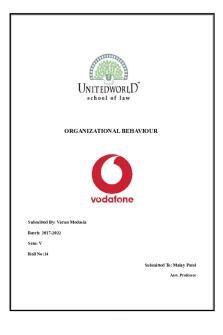
Organizational Behaviour Project
- 15 Pages
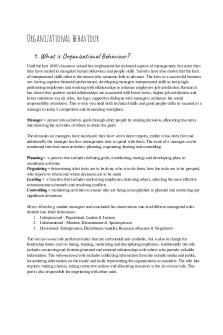
Organizational behaviour
- 67 Pages

Organizational Behaviour
- 2 Pages
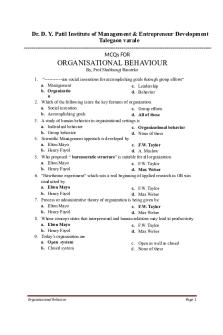
Organizational Behaviour mcqs
- 27 Pages
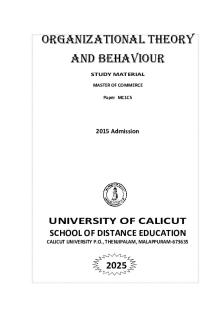
Organizational theory and behaviour
- 186 Pages
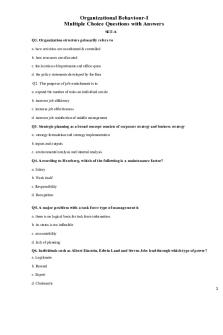
Organizational Behaviour MCQ SET
- 20 Pages

Chapter 2 ORGANIZATIONAL BEHAVIOUR
- 23 Pages

Organizational Behaviour Glossary
- 17 Pages
Popular Institutions
- Tinajero National High School - Annex
- Politeknik Caltex Riau
- Yokohama City University
- SGT University
- University of Al-Qadisiyah
- Divine Word College of Vigan
- Techniek College Rotterdam
- Universidade de Santiago
- Universiti Teknologi MARA Cawangan Johor Kampus Pasir Gudang
- Poltekkes Kemenkes Yogyakarta
- Baguio City National High School
- Colegio san marcos
- preparatoria uno
- Centro de Bachillerato Tecnológico Industrial y de Servicios No. 107
- Dalian Maritime University
- Quang Trung Secondary School
- Colegio Tecnológico en Informática
- Corporación Regional de Educación Superior
- Grupo CEDVA
- Dar Al Uloom University
- Centro de Estudios Preuniversitarios de la Universidad Nacional de Ingeniería
- 上智大学
- Aakash International School, Nuna Majara
- San Felipe Neri Catholic School
- Kang Chiao International School - New Taipei City
- Misamis Occidental National High School
- Institución Educativa Escuela Normal Juan Ladrilleros
- Kolehiyo ng Pantukan
- Batanes State College
- Instituto Continental
- Sekolah Menengah Kejuruan Kesehatan Kaltara (Tarakan)
- Colegio de La Inmaculada Concepcion - Cebu
